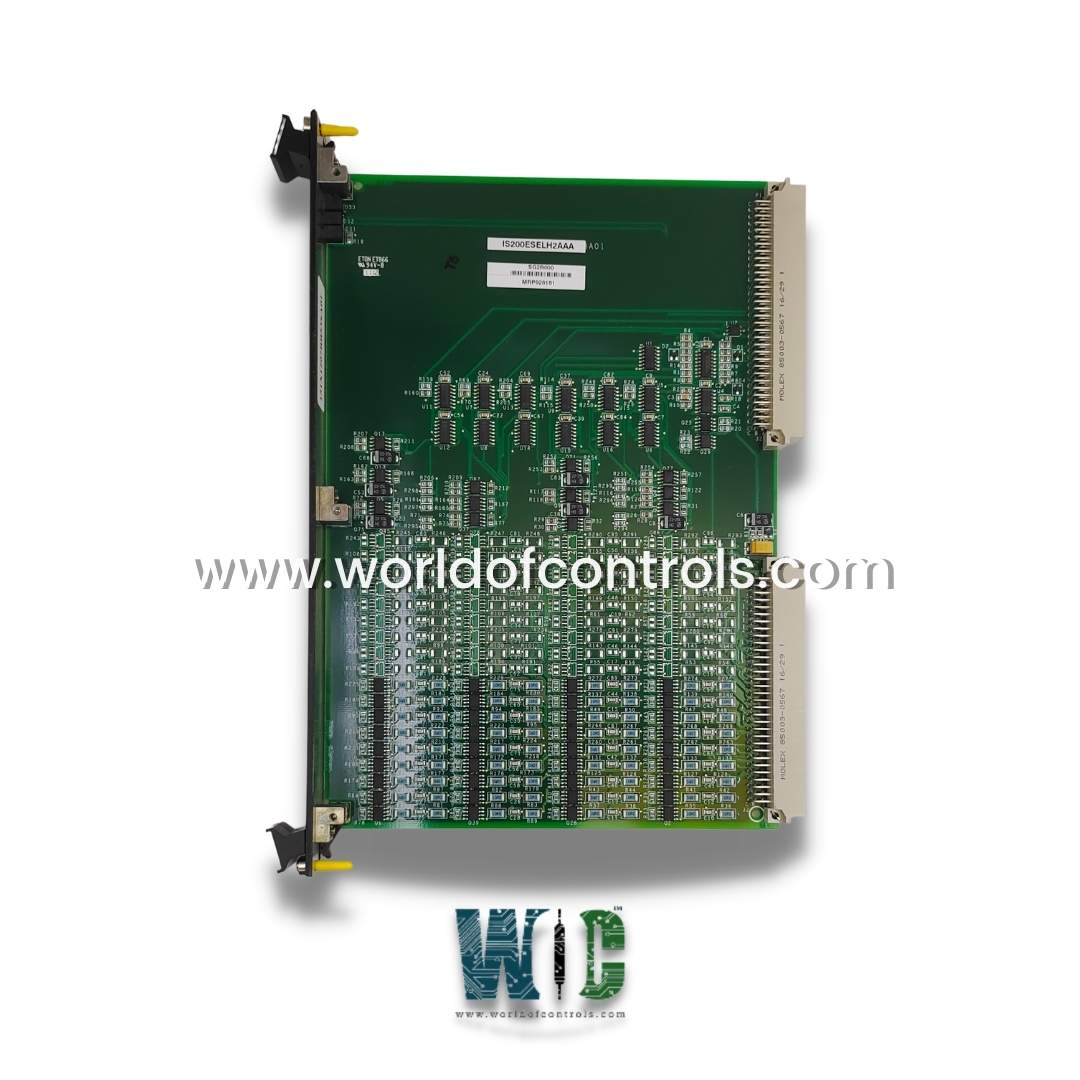
World Of Controls understands the criticality of your requirement and works towards reducing the lead time as much as possible.
IS200ESELH2AA - Exciter Selector Board is available in stock which ships the same day.
IS200ESELH2AA - Exciter Selector Board comes in UNUSED as well as REBUILT condition.
To avail our best deals for IS200ESELH2AA - Exciter Selector Board, contact us and we will get back to you within 24 hours.
SPECIFICATIONS:
Part No: IS200ESELH2AA
Manufacturer: General Electric
Product Type: Exciter Selector Board
Function: Help Fire Gate-Firing SCRs
Series: EX2100
Operating Voltage: +5V DC
Power Consumption: < 10 W
Signal Fanouts: 6
Availability: In Stock
Operating Temperature: 0°C to 60°C
Weight: 2.00 lbs
Dimensions: 19.00 x 12.50 x 3.50
Country of Origin: USA
Manual: GEI-100456
FUNCTIONAL DESCRIPTION:
IS200ESELH2AA is an Exciter Selector Board manufactured and designed by General Electric is part of the EX2100 Series used in Excitation turbine control systems. The board’s primary function is to receive gate pulse firing signals from the EMIO (Exciter Main I/O) board and transmit them to the gate driver circuits on the EGPA (Exciter Gate Pulse Amplifier) boards. This board supports up to three bridge drivers, making it suitable for multi-bridge excitation systems. The H2AA variant specifically includes conformal coating for enhanced durability in harsh or humid industrial environments. The ESEL board ensures accurate and secure transmission of SCR gate pulses and supports system redundancy by allowing dual input paths from redundant controllers (typically M1 and M2). It also performs signal validation and selection to prevent erroneous pulse delivery, playing an essential role in the safety, reliability, and real-time responsiveness of the turbine’s excitation system. Three ESEL board groups can support rising redundancy levels:
BOARD CONTROL:
For simplex systems, only one ESEL board is required to route gate pulse signals from the active EMIO to the exciter bridge drivers. However, in applications where system redundancy or online maintenance is critical, two ESEL boards are installed — one driven by controller M1 and the other by controller M2. In this dual configuration, controller C, which oversees system coordination, determines which ESEL board (ESEL 1 or ESEL 2) is actively routing pulses at any given time. This enables automatic or operator-initiated switching between control paths to ensure continuous operation in the event of a failure or for planned maintenance. Typically, ESEL 1 is powered and controlled by M1, while ESEL 2 is powered and controlled by M2. The default path is via M1 and ESEL 1, which remains active unless a fault is detected or a switchover is commanded.
OPERATION:
In a dual-controller EX2100 system with redundancy, six gating (firing) commands are transmitted to the Exciter Gate Pulse Amplifier (EGPA) boards, which in turn control the firing of the SCRs within the exciter bridge. These six commands are routed through the Exciter Selector Boards (ESELs) under the supervision of Controller C, which determines the active master controller — either M1 or M2. The selected controller serves as the active source, and only one controller is allowed to drive the gate commands at any given time to avoid conflicts or overlap. The ESEL board associated with the active controller — typically ESEL 1 for M1 or ESEL 2 for M2 — receives the pulse signals and distributes them to all six EGPA channels. Importantly, the system ensures that gating signals are never sourced simultaneously from both controllers, which prevents issues such as SCR cross-conduction or phase imbalance.
The active master controller (M1 or M2) not only provides the logic signals but also powers the gating path, supplying all necessary control energy for the six EGPA modules. The design of the ESEL board includes fanout circuitry that ensures reliable and synchronized distribution of the gate commands to each EGPA. Each of the six fanout channels is electrically isolated and independently buffered. As a result, if one fanout circuit experiences a fault or failure, for example, due to a component malfunction or an open output, it does not affect the remaining five channels. This fault containment characteristic is essential for maintaining system integrity and minimizing the risk of cascading failures.
WOC offers the industry’s largest inventory of replacement parts for GE Excitation Control Systems. We provide both unused and expertly rebuilt boards, all backed by warranty, along with reliable repair services for damaged components. Whether you're looking for OEM parts or custom automation solutions, our team of experienced professionals is available 24/7 to support your needs. For pricing, availability, or repair inquiries, please don’t hesitate to contact us via phone or email — we're here to assist you with prompt and dependable service.
How does the board support system redundancy?
The board supports dual-controller configurations. In redundant systems, two ESEL boards are installed—one powered and controlled by M1, the other by M2. A third controller (C) determines the active path, allowing seamless failover and supporting online repair without shutting down the excitation system.
How are the gate signals managed to prevent conflict between controllers?
Controller C enforces exclusive control logic. Only one ESEL board is active at a time, ensuring that gating commands are sourced from either M1 or M2, but never both simultaneously. This prevents cross-conduction and ensures SCR firing integrity.
What type of signals are routed through the ESEL board?
The board routes six pulse-width modulated gating signals used to trigger the SCRs in the exciter bridge. These signals are transmitted as differential digital logic levels or via fiber-optic links, depending on system configuration.